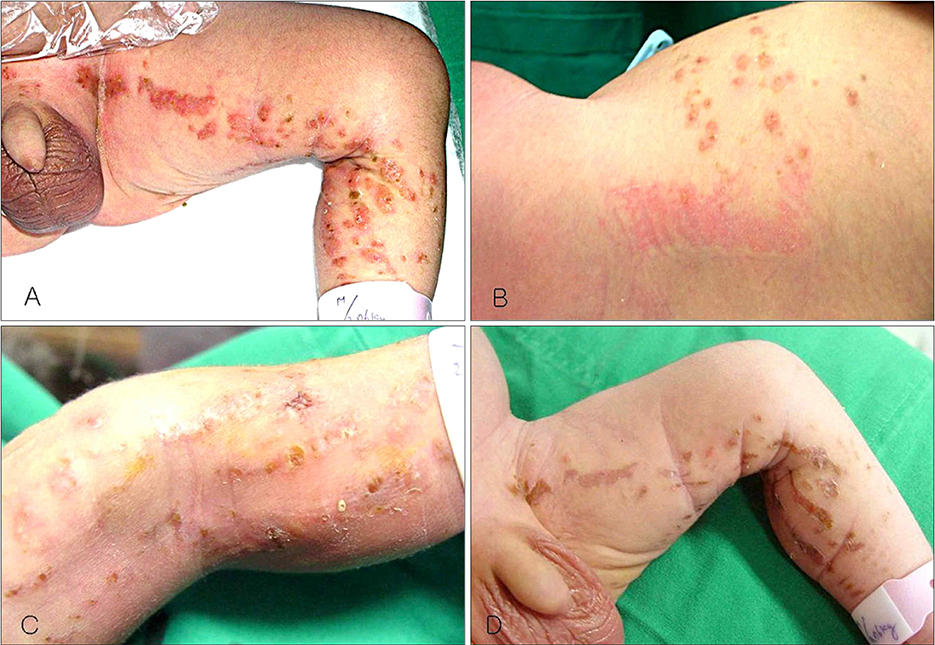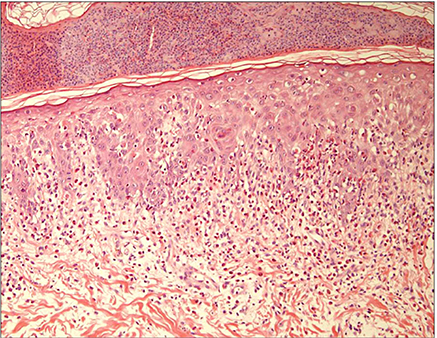Ann Dermatol.
2008 Sep;20(3):134-137. 10.5021/ad.2008.20.3.134.
A Case of a Surviving Male Infant with Incontinentia Pigmenti
- Affiliations
-
- 1Department of Dermatology, Chosun University Medical School, Gwangju, Korea. Derm75@hanmail.net
- KMID: 2156379
- DOI: http://doi.org/10.5021/ad.2008.20.3.134
Abstract
- Incontinentia pigmenti (Bloch-Sulzberger's disease) is an X-linked dominantly inherited disorder which is usually lethal in hemizygous males, but rarely found in male infants. It can be explained by the presence of an extra X chromosome (Klinefelter's syndrome), hypomorphic mutations, and somatic mosaicism. We herein report a rare case of incontinentia pigmenti with typical course of skin manifestation in normal karyotype (46, XY) male infant.
Figure
Reference
-
1. Hadj-Rabia S, Froidevaux D, Bodak N, Hamel- Teillac D, Smahi A, Touil Y, et al. Clinical study of 40 cases of Incontinentia pigmenti. Arch Dermatol. 2003; 139:1163–1170.
Article2. Berlin AL, Paller AS, Chan LS. Incontinentia pigmenti: a review and update on the molecular basis of pathophysiology. J Am Acad Dermatol. 2002; 47:169–187.
Article3. Pacheco TR, Levy M, Collyer JC, Parra NP, Parra CA, Garay M. Incontinentia pigmenti in male patients. J Am Acad Dermatol. 2006; 55:251–255.
Article4. Lenz W. Half chromatid mutations may explain incontinentia pigmenti in males. Am J Hum Genet. 1975; 27:690–691.5. Ormerod AD, White MI, McKay E, Johnston AW. Incontinentia pigmenti in a boy with Klinefelter's syndrome. J Med Genet. 1987; 24:439–441.
Article6. Park SS, Kook HI. A case of Incontinentia pigmenti in male. Korean J Dermatol. 1982; 20:487–489.7. Kim BJ, Lee DH, Shin HS, Won CH, Lee JH, Kwon OS. Incontinentia pigmenti in male infant. Korean J Dermatol. 2006; 44:624–626.8. James WD, Berger TG, Elston DM. Genodermatoses and congenital anormaly. Andrew's disease of the skin. Philadelphia: Elsevier;2006. p. 547–549.9. Scheuerle AE. Male cases of incontinentia pigmenti: case report and review. Am J Med Genet . 1998; 77:201–218.
Article10. Fusco F, Bardaro T, Famiani G, Mercadante V, Miano MG, Falco G. Molecular analysis of the genetic defect in a large cohort of IP patients and identification of novel NEMO mutations interfering with NF-kB activation. Hum Mol Genet. 2004; 13:1763–1773.
Article11. Goldberg MF. The skin is not the predominant problem in Incontinentia pigmenti. Arch Dermatol. 2004; 140:748–750.
Article12. Mayer EJ, Shuttleworth GN, Greenhalgh KL, Sansom JE, Grey RH, Kenwrik S. Novel corneal features two males with incontinentia pigmenti. Br J Ophthalmol. 2003; 87:554–556.13. Carney RG. Incontineatia pigmenti-A world statistical analysis. Arch Dermatol. 1976; 112:535–542.14. Mckee PH, Calonje E, Granter SR. Pathology of the skin with clinical correlation. Philadephia: Elsevier Mosby;2005. p. 702–704.15. Clayton-Smith J, Watson P, Ramsden S, Black GC. Somatic mutation in MECP2 as a non-fatal neurodevelopmental disorder in males. Lancet. 2000; 356:830–832.
Article16. Elder DE, Elenitsas R, Johnson BL, Murphy GF. Lever's histopathology of the skin. Philadelphia: Lippincott Williams & Wlikins;2005. p. 168–169.17. Landy SJ, Donnai D. Incontinentia pigmenti (Bloch-Sulzberger's disease). J Med Genet. 1993; 30:53–59.




